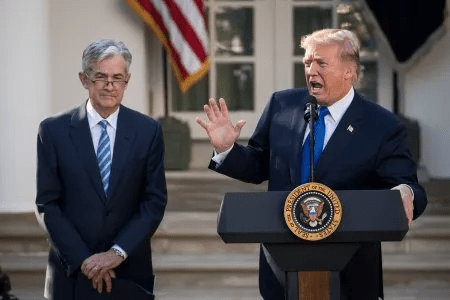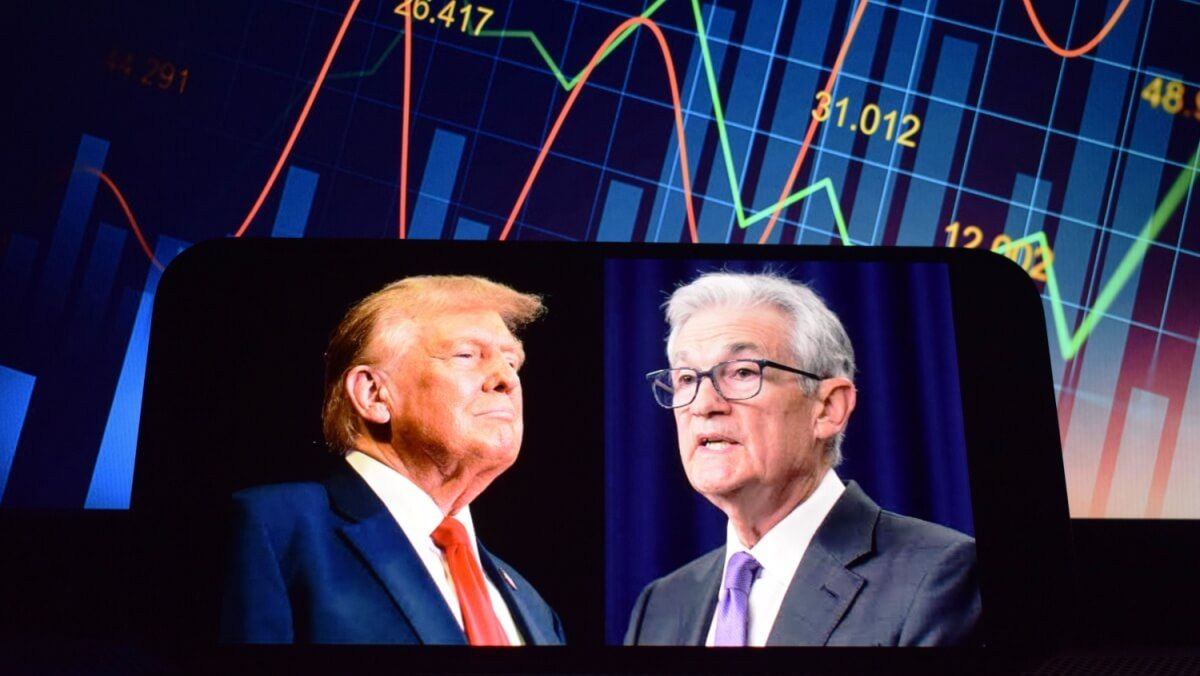#PowellVsTrump During a brief conversation with reporters on Wednesday, Trump said, "I don’t rule anything out, but it’s highly unlikely [that I would fire him] — unless he has to leave for fraud," after several reports revealed he had asked Republican lawmakers whether he should dismiss Powell. Markets reacted quickly: the dollar depreciated, Treasury yields rose, and stocks fell to a two-week low, prompting Trump to quickly walk back his comments.
For Trump, the alliance between him and "Jay" — as he referred to Powell during the 2017 Rose Garden announcement — has gradually unraveled. What started as warm support for Powell's "strength and wisdom" has turned into a years-long dispute over interest rates, with Trump labeling the Fed chair an "idiot" for refusing to lower borrowing costs according to his timeline.

⬆️U.S. President Donald Trump (D) introduces his nominee for chair of the Federal Reserve, Jerome Powell, during a press event in the Rose Garden at the White House on November 2, 2017, in Washington,..✅
For Trump 2.0, the dynamics have changed dramatically. This time, the president has surrounded himself almost entirely with loyal supporters, much more willing to implement his agenda than some of the officials who resisted him during his first term. Compared to 2017, when Trump was still learning to navigate Washington and frequently clashed with his own nominees, his current administration has faced little internal resistance.
However, Powell remains a singular case — a vestige of that earlier period when Trump was still assembling his team and had not yet consolidated his power over the Republican Party and the government machine. Powell's independence and the Federal Reserve's institutional resistance to political pressure have effectively made him the last major obstacle to Trump's ambitious plans for the next four years.
Trump, who campaigned for price reductions during his bid to return to the White House, insists that the economy is under control and suggested that anyone smart enough could take on the role of Fed chair.
"I only care about low-interest people," Trump told reporters. "To be honest, it’s not a hard job, assuming you’re smart," he said. "It could be one of the easiest jobs I’ve ever seen."
What would it really mean — legally, economically, and institutionally — if Trump followed through on his threat to remove Powell? Newsweek spoke with economists and political scientists to analyze the risks and potential consequences.
Trump's suggestion that he could remove Powell sparked an intense debate about what such a move would mean — legally, economically, and politically — at a time when inflation remains persistent and borrowing costs are already high.
"The administration sees Powell as a weakness, and the problem is that the midterm elections are approaching," said Todd Belt, director of the Political Management Program at George Washington University. He noted that Trump's team increasingly views Powell as a risk ahead of a crucial election season, especially with prices still high and interest rates at two-decade record levels.
At stake is the long-standing independence of the Federal Reserve from the White House. While presidents appoint the Fed chairs and can influence monetary policy through decisions and fiscal appointments, the law only allows a sitting chair to be removed "for cause," a term traditionally interpreted as misconduct or incapacity — not mere disagreement over policies.
Trump's allies have raised the idea of using the above-budget reform of the Fed's headquarters as a pretext, but legal experts said such a move would almost certainly be challenged in court.
"The real danger here is that this politicizes something that should never be political," Belt said. "We have rules that ensure the separation between what is political and what is for the public good. The Fed was designed to be independent, so that the president cannot manipulate monetary policy for short-term gains."
Trump's frustration stems largely from Powell's refusal to cut rates quickly enough to spur growth before the elections. The Fed has kept its benchmark interest rate at 4.25% to 4.5% this year, with Trump arguing that the rate is "at least 3 percentage points above expectations."
"Trump sees other central banks cutting rates and wonders why the Fed isn’t doing more for him politically," Belt added. "But the Fed's mission is to manage inflation and employment in the long term, not to serve the president."
Trump believes that replacing Powell with a loyal supporter — supposedly Treasury Secretary Scott Bessent — would result in lower borrowing costs for consumers and businesses and a stronger economy just in time for the midterm cycle. But this plan ignores a basic economic tension: aggressively cutting interest rates risks reigniting inflation, which already remains above the Fed's 2% target.
How markets might react
The idea of firing Powell sent shockwaves through the markets on Wednesday, with the dollar falling, Treasury yields rising, and stocks declining — reflecting investors' concerns that a politically compromised Fed would lose credibility. This reaction highlights why financial markets value central bank stability: the confidence that decisions about interest rates are made based on data, not presidential whims.
"One thing that financial markets value is consistency," Belt said. "If Trump were to oust the Fed chair, it would inject more chaos and unpredictability into the economy. Companies hesitate to hire, investment slows down. It’s bad for ordinary Americans because businesses don't like to reinvest and create new jobs if they don't know how the market will behave."
Lawrence White, an economics professor at NYU's Stern School of Business, noted that while presidents have influenced who leads the Fed, forcibly removing a sitting chair in the middle of a term would cross a line not seen since the Carter administration, when the Fed chair and the Treasury secretary discreetly swapped roles in a strange and secretive arrangement.
"It’s not just about one man," White said. "It’s about preserving the integrity of the institution. Presidents have always appointed chairs they hope will align with their priorities — that’s normal. But pushing Powell to vacate his seat? That’s confusing and undermines confidence in the Fed."
Rebecca Patterson, former investment strategist, said that global investors would likely view a sudden dismissal as evidence that the Fed was no longer independent. This could raise the cost of American debt and reverberate through the economy.
"If investors perceive that the Fed's independence is being diminished, they will demand higher yields to compensate for the additional risk of U.S. public debt," she said. "This makes mortgages and auto financing more expensive, and growth slows down."
As Belt said: "Forcing Powell out and replacing him with a 'yes man' sends the message that the U.S. economy is just another arm of the White House."
#BinanceHODLerERA #AltcoinSeasonLoading #Binance #USCryptoWeek $BTC $ETH $BNB




